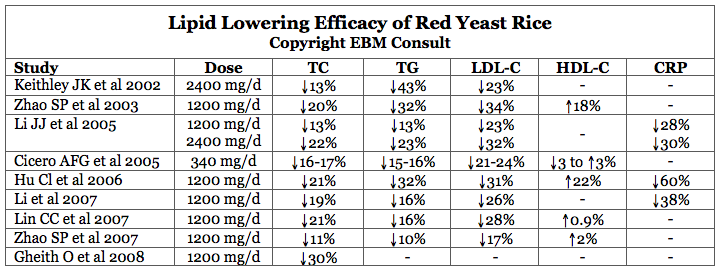Red
yeast rice is made from fermented rice containing the mold, Monascus
purpureus and is also marketed as Cholestin and Xuezhikang
supplements. It is most known for its lipid lowering properties and
possibly reduced risk for cardiovascular events. The lipid lowering
effects appear to reduce the total cholesterol (TC), low density
lipoprotein-cholesterol (LDL-C), triglycerides (TG) and possibly increase the
high density lipoprotein cholesterol (HDL-C).1-13 For an explanation for
how red yeast rice is able to improve the lipid profile, please review volume
2, issue 44 in the Natural Medicines archives.1-10
The
table below summarizes the effects of red yeast rice on the various lipid
indices or parameters.1-10 As noted, the majority of the literature and
lipid lowering effects reflect the use of red yeast rice in doses totaling 1200
mg per day (usually given as 600 mg twice daily by mouth). While 2400 mg
daily has also been studied, it is difficult to discern whether this additional
dose confers any additional lipid lowering benefits that are of clinical
significance. The average change in lipid parameters are as
follows: a reduction in TC by 11-30%, reduction in TG by 10-43%,
reduction in LDL-C by 17-35%, and an increase in HDL up to 22%. There is
also some limited data suggesting that red yeast rice can also reduce
c-reactive protein (CRP) levels.2,3,11

The
consistency in the changes of the lipid profile across several different
studies would suggest that red yeast rice in doses of at least 600 mg by mouth
twice daily does provide a beneficial effect. Whether or not these
improvements in lipid parameters helps patients to achieve their patient specific
cholesterol goals or if it translates into an improvement in mortality across
all patient populations is not definitively known.
References:
- Li JJ, Wang Y, Nie SP et al. Xuezhikang, an extract of cholestin,
decreases plasma inflammatory markers and endothelin-1, improve
exercise-induced ischemia and subjective feelings in patients with
cardiac syndrome X. Int J Card 2007;122:82-4.
- Hu Cl, Li YB, Tang YH et al. Effects of withdrawal of
Xuezhikang, an extract of cholestin, on lipid profile and C-reactive
protein: a short-term time course study in patients with coronary artery
disease. Cariovasc Drugs Ther 2006;20:185-191.
- Li JJ, Hu SS, Fang CH et al. Effects of xuezhikang, an extract
of cholestin, on lipid profile and C-reactive protein: a short-term
course study in patients with stable angina. Clinica Chimica Acta
2005;352:217-24.
- Cicero AFG, Brancaleoni M, Laghi L et al. Antihyperlipidaemic
effect of a Monascus purpureus brand dietary supplement on a large
sample of subjects at low risk for cardiovascular disease: a pilot
study. Complement Ther Med 2005;13:273-8.
- Zhao SP, Liu L, Cheng YC et al. Effects of xuezhikang, a
cholestin extract, on reflecting postprandial triglyceridemia after a
high-fat meal in patients with coronary heart disease. Atherosclerosis
2003;168:375-80.
- Keithley JK, Swanson B, Sha BE et al. A pilot study of the
safety and efficacy of cholestin in treating HIV-related dyslipidemia.
Nutrition 2002;18:201-4.
- Gheith O, Sheashaa H, Abdelsalam M et al. Efficacy and safety of
Monascus purpureus Went rice in subjects with secondary
hyperlipidemia. Clin Exp Nephrol 2008;12:189-194.
- Liu L, Zhao SP, Cheng YC et al. Xuezhikang decreases serum
lipoprotein(a) and C-reactive protein concentrations in patients with
coronary heart disease. Clinical Chemistry 2003;49:1347-1352.
- Lin CC, Li TC, Lai MM. Efficacy and safety of Monascus purpureus
Went rice in subjects with hyperlipidemia. Eur J Endocrinol
2005;153:679-86.
- Zhao SP, Lu ZL, Du BM et al. Xuezhikang, an extract of
cholestin, reduces cardiovascular events in type 2 diabetes patients
with coronary heart disease: subgroup analysis of patients with type 2
diabetes from China coronary secondary prevention study (CCSPS). J Card
Pharmacol 2007;49:81-4.
- Li JJ, Lu ZL, Kou WR et al. Beneficial impact of Xuezhikang on
cardiovascular events and mortality in elderly hypertensive patients
with previous myocardial infarction from China Coronary Secondary
Prevention Study (CCSPS). J Clin Pharmacol 2009;49:947-956.
- Lu Z, Kou W, Du B et al. Effect of Xuezhikang, an extract from
red yeast Chinese rice, on coronary events in a Chinese population with
previous myocardial infarction. Am J Cardiol 2008;101:1689-93.
- Lu ZL, Collaborative Group for China Coronary Secondary
Prevention Using Xuezhikang. China coronary secondary prevention study
(CCSPS). Zhonghua Xin Xue Guan Bing Za Zhi 2005;33:109-15.
- Food and Drug Administration. FDA warns consumers to avoid red
yeast rice products promoted on internet as treatments for high
cholesterol products found to contain unauthorized drug. FDA News
Release. August 9, 2007.


